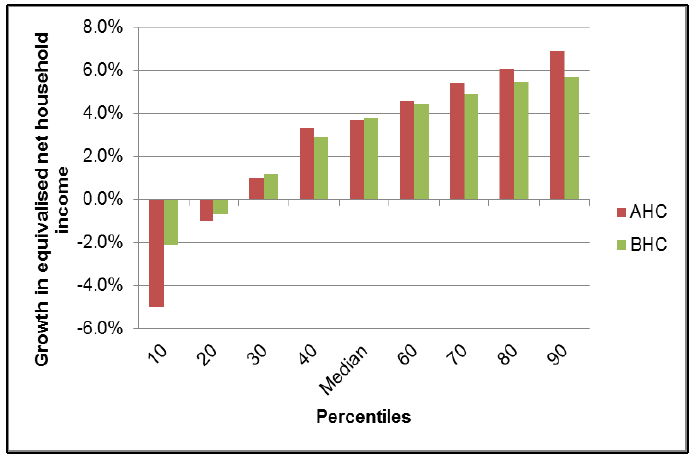Welfare Reform (Further Provision) (Scotland) Act 2012: annual report 2017
Report on the impacts of the Welfare Reform Act 2012 on the people of Scotland and other welfare measures passed since 2010.
6. Impact of welfare reform on income inequality and poverty
In March 2017, The Institute of Financial Studies ( IFS) published the results of an analysis [76] which quantified the expected impact of UK welfare changes (and personal tax changes) on income inequality in the UK and poverty rates in the UK. Parts of this analysis have been subsequently updated to take account of new outturn figures on income and poverty for 2015/16 [77] . The results of their analysis are available publically and are summarised in this section of the report. Separate Scotland level analysis is not available at this time.
Our summary focuses on the period 2016-17 to 2021-22, and takes into account reforms to social security that are being rolled out during this time. Official statistics on income and poverty are reported with a lag, so these projections give us the best indication of the full impact of recent welfare reforms.
6.1 Income Inequality
Over the period between now and 2020/21, the IFS are projecting an increase in income inequality. That is, the gap in income between the richest and poorest households is expected to increase.
Figure 7 shows IFS predicted change in real household income between 2016-17 and 2020/21, both on a before housing cost ( BHC) and an after housing costs ( AHC) basis for different parts of the income distribution. The highest income households are expected to benefit the most over this time period, and this stands in contrast to projected falls for the lowest income households, especially when measured after housing costs have been deducted.
The key determinants of household income that inform this IFS analysis are income from employment and income from benefits. In general, lower income households are more likely to receive at least some of their income from benefits, whilst for higher income households, earnings make up the larger share of their income.
Figure 7: Change in real household BHC and AHC income between 2016-17 and 2021-22 by percentile point

(Source: IFS)
Benefit cuts therefore have the greatest impact on those on the lowest incomes and this is responsible for the falls in income predicted for the bottom 20% of the income distribution. The IFS highlight three reforms of particular importance:
- The continued freeze in most working-age benefits which are expected to reduce the real value of these benefits by 5% between now and 2020, based on current inflation forecasts.
- Cuts to the generosity of tax credits for families with children
- The roll out of universal credit, which is expected to reduce government spending by around £5 billion a year in the long run
At the other end of the income distribution, the main reason why incomes are set to increase is due to forecasted increases in real earnings. Although this will also benefit those in paid employment on lower incomes, because earnings make up a lower proportion of their income, they will not benefit to the same extent.
Once housing costs are deducted, the outlook for income inequality looks even worse. The key reason for this is that changes brought in by the Coalition and Conservative UK governments (such as changes to LHA rates) mean that housing benefit will not rise to offset increasing housing costs for many low income households.
6.2 Poverty and Child Poverty
As a result of these rising levels of income inequality, levels of relative poverty are expected to rise. Child poverty is expected to increase more than overall poverty because of the focus of the benefit cuts on households with children, as shown in Figure 8.
Figure 8: Long-run impact of planned [78] tax and benefit reforms by income decile and household type
![Figure 8: Long-run impact of planned[78] tax and benefit reforms by income decile and household type Figure 8: Long-run impact of planned[78] tax and benefit reforms by income decile and household type](/binaries/content/gallery/publications/report/2017/06/welfare-reform-further-provision-scotland-act-2012-annual-report-2017/00522007.gif)
(Source: IFS)
In a recent paper, the IFS model expected changes to absolute poverty. Absolute poverty measures whether living standards are improving for the lowest income households by comparing real incomes to a fixed point in time.
As a result of the focus of cuts on households with children the IFS expects the number of children in absolute poverty to increase. In their May 2017 briefing note, the IFS have updated their projections to show that absolute child poverty AHC will increase from 27.1% in 2015/16 to 31.6% in 2020/21, which is a return to levels not seen since the early 2000s.
It is important to note that poverty rates can be influenced by a number of factors, and IFS projections factor in both changes in income and changes in composition of households, which in itself can be a driver of poverty. For example, the IFS note in their March 2017 paper that at the UK level, lone parent families are twice as likely to be in absolute poverty than two parent families and as the proportion of lone parent families is expected to increase over the period to 2020/21, this in itself will increase poverty. However, over the time period in question, income effects rather than compositional effects are expected to be the dominant factor in increasing levels of poverty.
Contact
Email: Philip Duffy, Philip.Duffy@gov.scot
Phone: 0300 244 4000 – Central Enquiry Unit
The Scottish Government
St Andrew's House
Regent Road
Edinburgh
EH1 3DG
There is a problem
Thanks for your feedback